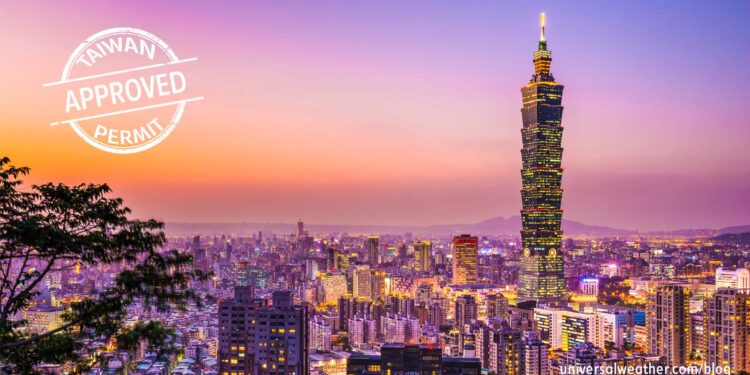Taiwan Landing and Overflight Permits for Business Aircraft Operators

While landing permits for Taiwan are fairly straightforward for business aircraft operators, there are lead times to be mindful of. Be aware that overflying Taiwan will impact your ability to land in China – and vice versa. Always give yourself plenty of time to assemble required documentation and sponsor information when requesting Taiwan permits.
The following is an overview of what you need to know:
1. Know permit requirements for Taiwan
All aircraft traveling to Taiwan, both private non-revenue and charter (non-scheduled commercial), require landing permits. Likewise, all aircraft transiting Taiwan’s airspace must have overflight permits. These permits are processed by Taiwan Civil Aeronautics Administration (CAA). The permit office operates 24/7, even on holidays.
2. Be aware of Taiwan landing permit requirements
Information that CAA requires is the same for both private non-revenue and charter operations. For landing permits you’ll need to provide full schedule, aircraft tail number, operator name and address, full crew and passenger information, and a business contact. Purpose of your flight and a local business contact must be provided to CAA prior to a landing permit being issued. Required documentation includes your noise certificate, Maximum Takeoff Weight (MTOW) from the aircraft manual, and a copy of the worldwide insurance. Due to noise control charges levied in Taiwan, all flights operating to the island must provide the Effective Perceived Noise in Decibels (EPNdB) for the aircraft. It’s important to provide CAA with the full name of your local business contact, his or her title, and the company he or she works for, along with complete contact information. This business contact will need to create a sponsor letter for the landing permit. Ground handlers can assist with this process, and be aware that in most cases CAA will communicate with your business contact to confirm information provided. Note that worldwide insurance does not need to be sent in advance but will be checked on arrival by local authorities.
3. Be aware of Taiwan overflight permit requirements
When applying for a Taiwan overflight permit, you’ll need to supply operator name and address, along with crew and passenger information. Noise certificate, as well as MTOW from aircraft manual, must be submitted along with the overflight request. When the overflight permit is approved, you’ll receive a confirmation. The same applies for Taiwan landing permits. Any permit confirmations must be placed in the flight plan remarks section 18.
4. Permit lead times can be somewhat long
Official lead time for a Taiwan landing or overflight permit is 10 business days. Short-notice requests are also possible; however, these requests must be sent to a different office within CAA.
5. Be aware of local flying restrictions
Restrictions exist in flying between Taiwan and mainland China. You’ll need to avoid overflying Chinese airspace en route to Taiwan, and when flying to China you must avoid overflying Taiwan airspace. However, flights between China and Taiwan are permitted when they are medical emergency or air ambulance flights. There are no operating restrictions between Taiwan and Hong Kong (VHHH) and Macau (VMMC), so long as route of flight does not pass over the Chinese landmass.
Be aware of domestic travel restrictions within Taiwan. Non-Taiwanese aircraft may not operate domestically within the country if there are passengers, cargo, or mail onboard – a form of cabotage. Ferry flights, however, are permitted between domestic points in Taiwan by non-Taiwan-registered aircraft.
6. Consider permit revision procedures
Taiwan landing and overflight permits are valid for the Zulu day of and Zulu day prior to approved day of flight. When operating earlier than the approved permit time, you’ll need to send a revised permit request, and a new permit number may be issued. For later operations, the permit number will remain the same, but you’ll need to send notification of schedule change. For changes to origin or destination of flight, send a revised permit request, and a new permit number may be issued. Likewise, for routing or aircraft tail number changes, send a revised permit request, and a new permit number may be issued. For crew or passenger changes, it’s a notification only, and your permit number will remain the same during the valid period. Note that no notification is required for routing changes, if route change is outside Taiwan’s flight information region (FIR) and if origin/destination remain the same.
7. Other tips to keep in mind
Routings must be provided with all permit requests, and you must use the CAA-approved routing. When landing permits are issued for Taipei (RCTP), airport slots will also be approved. Popular business stops in Taiwan include RCTP, Kaohsiung (RCKH), and Taipei Songshan (RCSS), with RCTP being the most popular destination for general aviation (GA) operations. Full aircraft services are available at these airports, but services may be limited at outlying airports in Taiwan.
Conclusion
Ensure that your Taiwan business contact is in place prior to requesting landing permits, and be aware that CAA will communicate with them. When planning operations to Taiwan, it’s important to be aware of restrictions in place with China, as well as cabotage issues within Taiwan.
Questions?
If you have any questions about this article or would like assistance planning your next trip to Israel, contact Christine Vamvakas at christinevamvakas@univ-wea.com.




